Chicago Red Stars go into the 2020 NWSL campaign hoping to finally make one step further than the past few seasons and win it. Last season saw them make it to the playoff finals against the reigning champions North Carolina Courage. The Red Stars have made the playoff semi-finals in four of the past five seasons getting ever closer to the title. The Courage have now won two back to back NWSL titles and will be considered the favourites going into this season.
The Red Stars scored 42 goals and conceded 32 in the process. The majority of those goals came from Sam Kerr. The Australian striker was the focal point of a dynamic team but her departure to Chelsea now means the Chicago team must find another reliable goalscorer. With the exception of Kerr (18), no other Red Stars player managed to record double figures in terms of goals in the 2019 season. Their next best was eight.
With the 2020 season starting next month, it remains to be seen if Chicago Red Stars can scale the heights of previous campaigns now that their star-studded striker has departed. This tactical analysis scout report will explore their style of play and the key players for the upcoming season. We will also explore the different options the Red Stars have in replacing Kerr and whether or not they will have to adapt their play style as a result.
NWSL 2020 Draft
The main topic surrounding the draft was how Chicago are going to replace Kerr after her move to England. The 2020 Draft has begun well for the Red Stars acquiring Rachel Hill, a first-round selection in the 2021 NWSL College Draft, the 19th overall selection in the 2020 NWSL Draft and allocation money from Orlando in exchange for the 3rd and 26th overall selection in the Draft. The Red Stars started the first day of business by trading away their fourth and fifth first-round picks plus allocation money to Sky Blue FC for its No. 2 and 3 picks. They quickly traded away their No. 2 pick to Portland Thorns for picks No. 15 and No. 16 plus allocation money.
After multiple trades, they finally made their first pick at No. 15 by picking up defender Julia Bingham followed by Virginia’s Zoe Morse with the 19th pick, Duke’s Ella Stevens with the 24th pick and Yale’s Aerial Chavarin with the 35th pick.
At the time of writing, these are Chicago’s current new transfers but the plan of replacing Kerr still remains unsolved. Bringing in Hill is a start along with the earlier drafts of Makenzy Doniak who brought in from Utah Royals in exchange for Chicago’s second-round draft pick in the 2021 NWSL College Draft. Kealia Ohai is the final forward to be brought in with Katie Naughton moving across to Houston Dash and the 18th overall selection in the 2020 NWSL College Draft.
General structure
Chicago Red Stars often lined up in a 4-2-3-1 system with a mostly settled team by the latter half of the campaign. The Women’s World Cup had seen the likes of Alyssa Naeher, Julie Ertz and Morgan Brian called up but upon their return, we soon saw a settled back four. Naeher as the first choice goalkeeper who was protected by Katie Naughton and Sarah Gorden. They were flanked by Casey Short and Tierna Davidson. However, after Naughton was dropped, Ertz was shifted from her usual defensive midfield position into a centre-back role. This pushed Gorden out to full-back, with Davidson moved into a central role. Eventually, Rory Dames settled on Naeher, Short, Ertz, Davidson, and Gorden as his first choice back four for the rest of the NWSL season.
Further forward, Danielle Colaprico partnered Brian as the double-pivot. The front four consisted of Vanessa DiBernardo as the number ‘10’ flanked by Yuki Nagasato and Savannah McCaskill with Kerr taking her customary place as the number ‘9’.
While we’ll dive into the tactics in more detail and depth, they generally played with a balanced duo in midfield with Colaprico playing a more conservative role and Brian venturing forward. However, both were positionally aware and provided a base for the Red Stars to work off of.
Nagasato was the team’s creative focal point off the left side. The Japanese international often drifted into central areas to play closer to Kerr where the two created a partnership. Nagasato assisted seven of Kerr’s 18 goals in the 2019 season. The understanding the two developed was beneficial for Chicago Red Stars. McCaskill and Nagasato’s role was to supply Kerr with through balls and long passes from their positions in the half-space. DiBernardo would make late runs to pounce on any cutbacks or second balls Kerr won.
Build-up play
Dames has been an advocate of patient yet quick exchanges when transitioning between thirds. Their usual build-up involves patiently passing the ball between the centre-backs eventually finding its way to the full-backs. The two full-backs – Short and Gorden – push forward with Colaprico or Ertz dropping in between the central defenders to add an extra body whilst the rest of the team push slightly forward. The Red Stars drop ever so slightly so the team can easily collect possession and lull the opposition into playing slightly higher, allowing Kerr and the rest of the attack to run in behind. Once possession reaches the full-backs they tend to drive forward with the wingers dropping into a more central position in the half-space and receive passes.
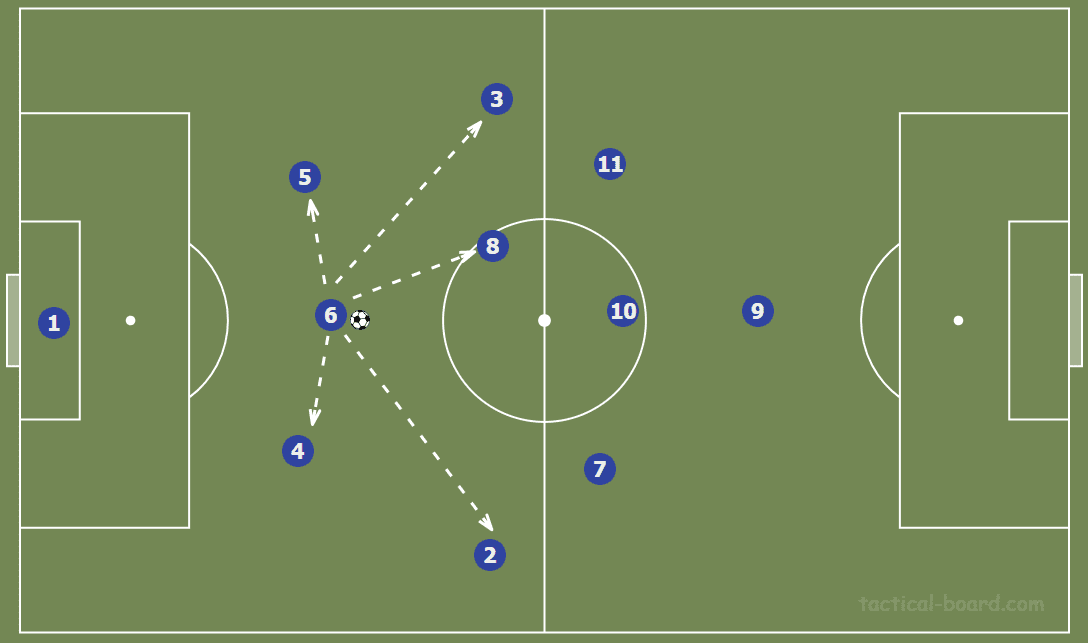
Once the wingers receive possession in the half-space their main course of action is to attempt a diagonal cross into Kerr or beyond her, relying on the Australian’s pace and positioning to latch onto the ball. However, in case the crossing option is blocked, the near-sided full-back makes an overlapping run to create a different angle for the cross. They try to attempt switch of plays when it’s available to free up a certain side but for the most part they attempt the cross.
When releasing possession from the back they reminisce a 3-4-3 structure to allow more bodies in midfield where they tend to have the ball most of the time. The two central midfielders are very flexible in their roles as they adapt to the team’s position and needs. If the build-up is slow and moves up a certain flank, they position themselves nearby to provide a passing option and help facilitate a switch of play. As I mentioned earlier, Colaprico/Ertz are more defensive-minded whereas Brian has played a more attacking role.
Attacking structure
Chicago Red Stars’ attacking structure was built around Kerr last season. Playing in a 4-2-3-1 system, the Red Stars looked to use their two wide players to feed Kerr and have DiBernardo sweep up any knockdowns or loose balls that Kerr contested. Brian and Colaprico/Ertz have an important role by acting as the pendulum in midfield as they both have certain roles. Colaprico or Ertz play a more defensive role, acting as the simplest passing option in case the wide areas are blocked.
Any time the ball is being passed in midfield, they are usually at the heart of their play. Brian, on the other hand, plays a more advanced, attacking role where she drives forward and makes runs off the ball to create more bodies in the final third. The two wide players are most critical to the Red Stars’ attacking play. As I mentioned in the build-up section, the full-backs look to play in the wide players who in turn try to look to drive into the channels to get closer to the box to either cross or play through balls for Kerr. More than McCaskill, it is Nagasato that the team relies on to service Kerr. Having scored 41 goals last season, it is safe to say their attack didn’t lack with an Expected goals (xG) rate of 1.68.
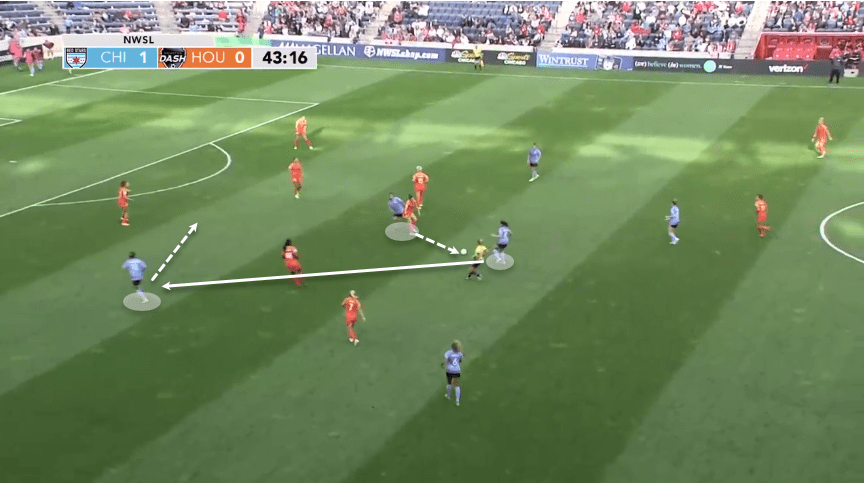
Here we can see one example of the Red Stars’ attacking combination with three of the four forward-thinking players involved. Kerr drops deeper to collect possession and plays the ball back to DiBernardo. The Houston Dash are defending in a compact position packing the central area in a square-like shape. Nagasato takes advantage of this situation and drifts away to the left with no close marker around her. The number ‘10’ knows where Nagasato is and her intention is to pass it into the wide left channel.
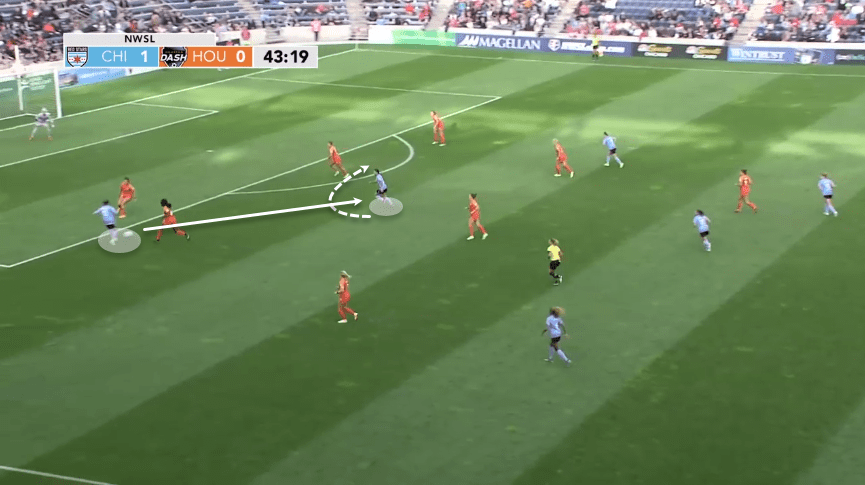
Nagasato receives possession and brings it slightly into a central area and drags two defenders towards her. This inevitably has created a gap in central defence for Kerr to pick up. Instead of driving forward into the empty space being followed by the highlighted centre-back, Kerr dummies the defender and takes an extra touch to the right and fashions herself a goal-scoring chance.
How do the Red Stars replace Sam Kerr?
Kerr’s move to Chelsea has created a big hole in the Red Stars’ squad and replacing an 18 goal a season striker isn’t easy. Having brought in Hill, Ohai, and Doniak, Dames has a number of choices to play in the centre-forward area, however, this may mean the team has to change the way they play. Kerr is a complete forward. She was the team’s focal point, winning long balls like a target man, breaking lines like a poacher, pressing defenders like an advanced forward, or linking-up play like a trequartista. With the ability to play numerous roles, Kerr was able to adapt to her team and play to her team’s strengths.
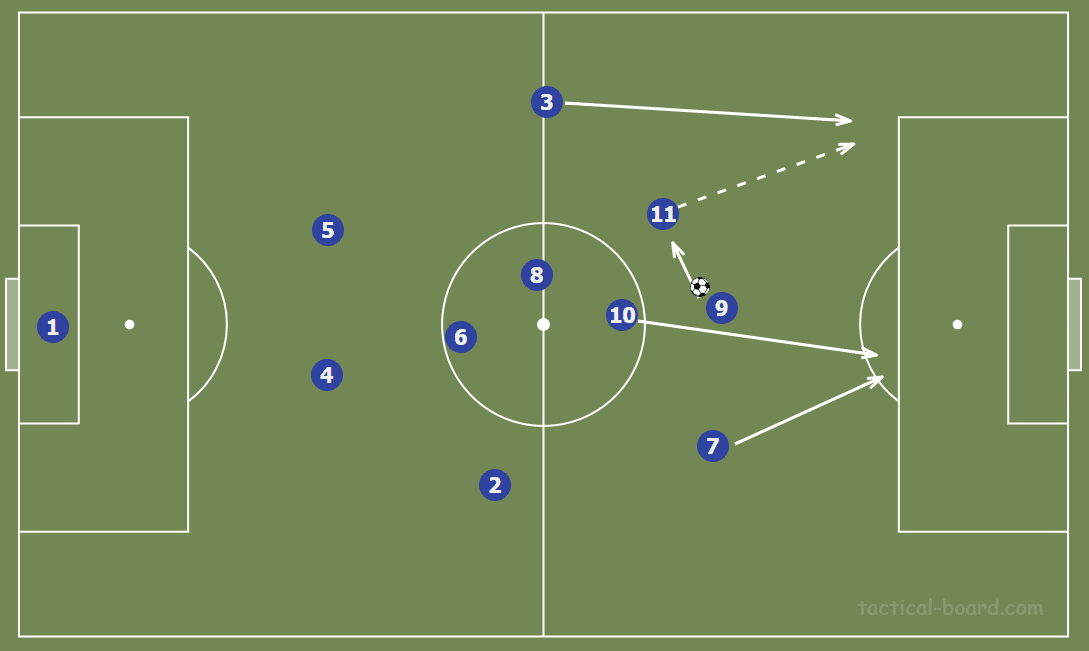
Changing the team’s style of attacking could be the answer here. Instead of trying to find a like-for-like replacement, the Red Stars could be better off compensating for her skills through other players by altering the system. Playing with a false nine and shadow striker could utilise the team’s strength in the attacking midfield areas. DiBernardo’s role could be made into one of a shadow striker who would make more runs in behind.
Nagasato has won 76.9% of her 1v1 battles when playing as a left attacking midfielder meaning she can beat an isolated defender on the ball. Nagasato also engages in 3.75 dribbles per 90 minutes as a striker across six matches in the NWSL last season. Both of these statistics prove her ability on the ball meaning she can adapt and use possession wisely in the event the wide attackers cannot get involved.
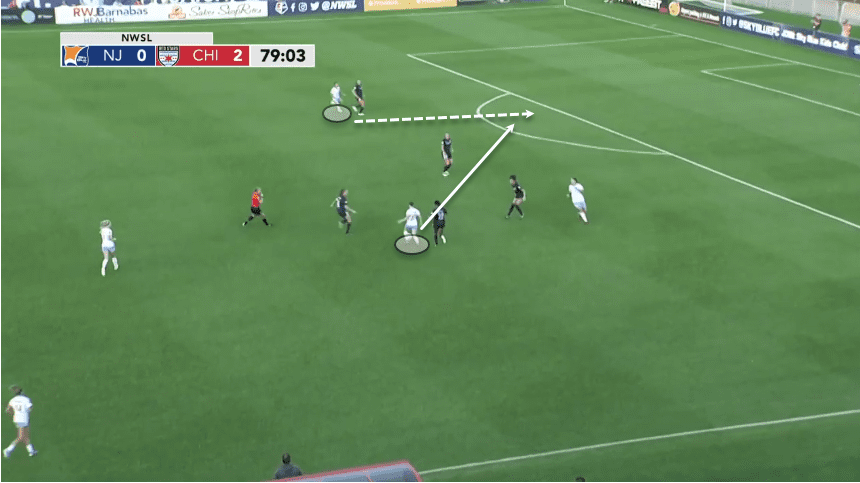
While she isn’t the quickest, her positional awareness is what allows her to play in a wide attacking role. As we can see in this example, the Red Stars are counter-attacking Sky Blue through Zoey Goralski and both Kerr and Nagasato are moving into a favourable position on the opposite side. What’s interesting is Nagasato uses her position behind the defender to gain an extra couple yards to latch onto Goralski’s through pass. The Japanese international is able to move into the box and score.
This move would not only bring the best out of the current recruits but also utilise the new signings that have been transferred in during the Draft. Hill, Ohai, and Doniak are all attackers that can play across the front four positions, however, they aren’t as prolific. For example, Hill is primarily a right-sided attacking midfielder who relies on her expert passing and defensive work-rate. Whilst playing for Orlando Pride last season she only managed to register four goals in 24 appearances and seems unlikely to carry the goal-scoring burden. However, with her passing and ability to beat a defender in one v one situations, Hill could act as a player to allow for more direct runs to attack the spaces in behind that is created by Nagasato.
Defensive structure
Defending is probably now, the Red Stars’ strongest asset. Looking at an analysis of their defensive structure it is easy to see how they are strong in this regard. They primarily look to keep a close compact shape amongst the back four. The two full-backs tuck in to create smaller gaps thus not allowing easy through balls and stopping runners going in behind. Out of possession, they often transform into a 4-4-1-1 shape with the two banks of four providing a solid foundation. The two wide attackers serve a dual purpose in this regard. They will track back to aid the full-backs in defending the wide areas and move into midfield to aid the press in the event the opposition attack from the central areas.
This coincides with their pressing structure where the defensive midfielder plays an extremely important role for the team. The player offers a passing option in building out from the back and slots in between the central defenders to provide an extra body in defence. They also look to get into good defensive positions to either press or block passing lanes to push the opposition towards the wide areas. The two full-backs are quick and effective in one v one situations even more so with the help of the two wingers.
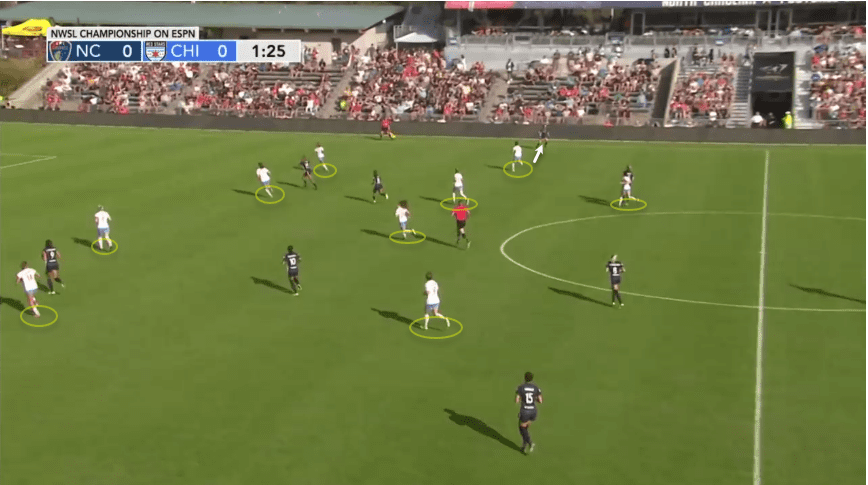
The team adopts a midfield pressing structure that looks to close down players more tightly and aggressively the higher the opposition gets. Above we can see an example against North Carolina Courage. The Red Stars are setup in a 4-4-1-1 system with the Courage on the attack. The two wide players have tucked in to force them to go out wide. As the ball is fed the team automatically shifts across towards the ball receiver. The wide left attacker will now either try to force her back, dispossess her, or force her down the line towards Short. Each scenario keeps the opposition away from the central area where the Courage are most potent.
Chicago Red Stars conceded 1.23 goals per 90 minutes throughout the season which set the tone for their excellent defensive work. They ended up with slightly better average defensive statistics than their opponents making more interceptions (54.5 vs 52.5), aerial duels (44 vs 43.81), and defensive duels (71.23 vs 69.08) per 90 minutes to name a few. The average positions are shown in the pass map below highlighting the important role the defensive midfield plays. Whether it is Colaprico or Ertz, the player remains in close proximity to the central defenders offering them exclusive protection and a passing option. Both women are good on the ball and offer simple forward passes to recycle possession and keep the team moving forward.
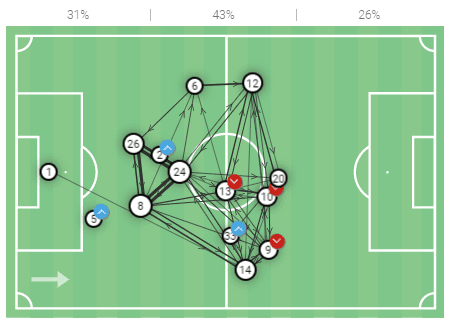
The most important component of the Red Stars’ defensive success was defensive stalwart Ertz. The team’s cog, Ertz’s natural position is at defensive midfield but was versatile enough to fill in at centre-back when Arin Wright went out of the team. Her sense of awareness and ability to sniff out danger early was her most valuable trait and asset. Knowing which position to be in to stop interceptions and make blocks was uncanny. The phrase ‘being at the right place at the right time’ often springs to mind when it comes to Ertz’s defensive performances. Seldom did she have an off night and when she did, so did the team. The American averaged 7.02 interceptions and 11.8 recoveries per 90 minutes last season proving her involvement and positional awareness. Ertz is excellent on the ball and her wide array of passing combined with her composure bailed the team out of many pressing situations.
Conclusion
Chicago Red Stars will find it slightly difficult to muster a repeat of their accomplishments of last season and replacing Kerr will be their biggest concern and dilemma. However, tweaking their system by utilising the players they have at their disposal could be the key to success for Dames and co. The addition of the young exciting talented forwards could freshen up the Red Stars’ attacking unit whilst still remaining a formidable defensive unit. Either way, it’ll be very interesting to see how the Chicago based team fare in the upcoming season.






Comments